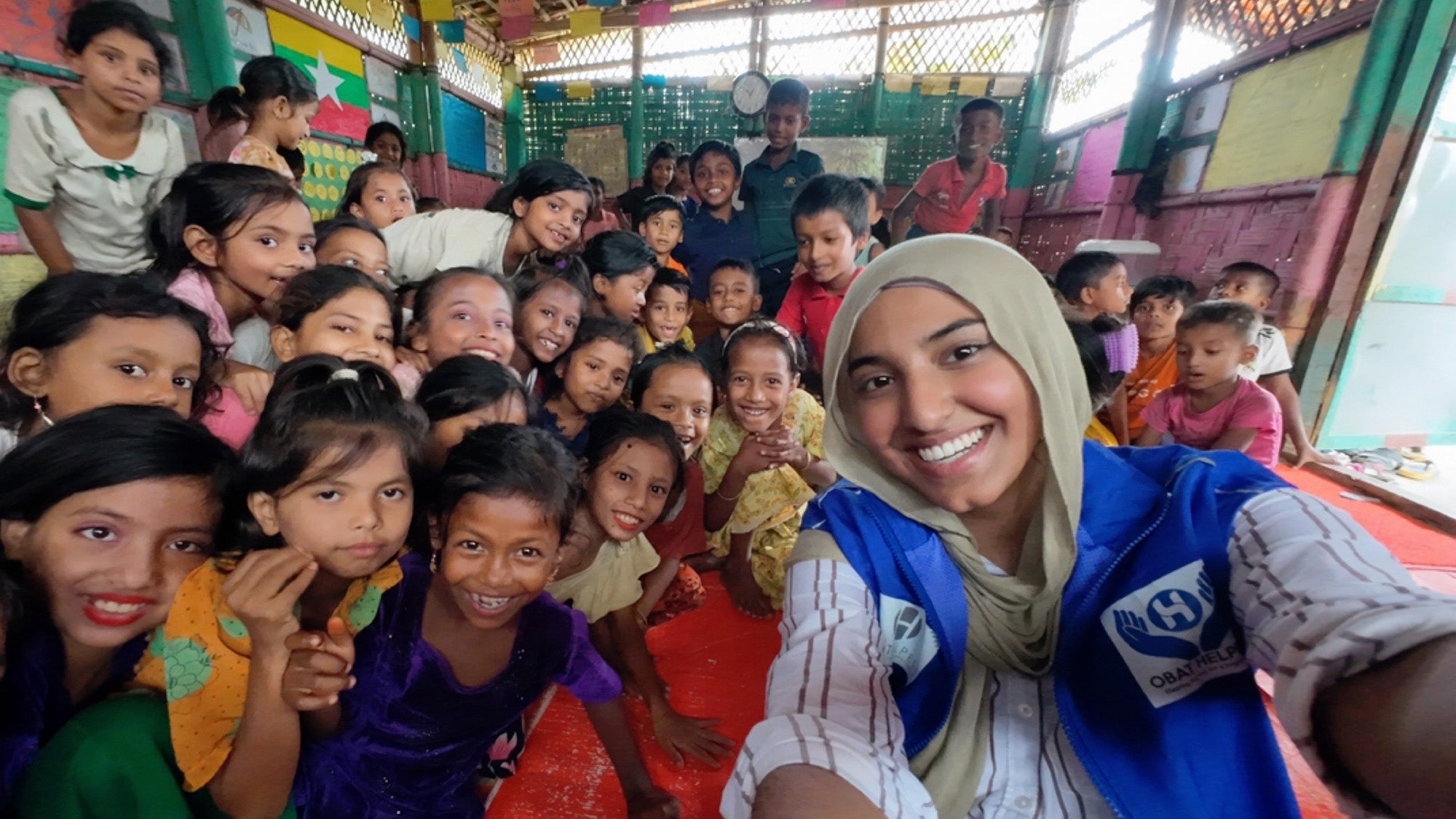School of Health Student Reflects on Her Summer Working With Rohingya Refugees
(August 28, 2025) — Less than two weeks after returning from her summer volunteer work with refugees in Bangladesh, Isra Satiar (H’26) drew on her experiences when addressing the 1,600 members of Georgetown’s Class of 2029 during Georgetown’s New Student Convocation on August 23. Satiar encouraged the incoming Hoyas to “lean into the community around you and allow it to shape you, just as it has shaped me.”
The human science major credits her School of Health community, where she is also student body president, for inspiring her to pursue her interests in global health.
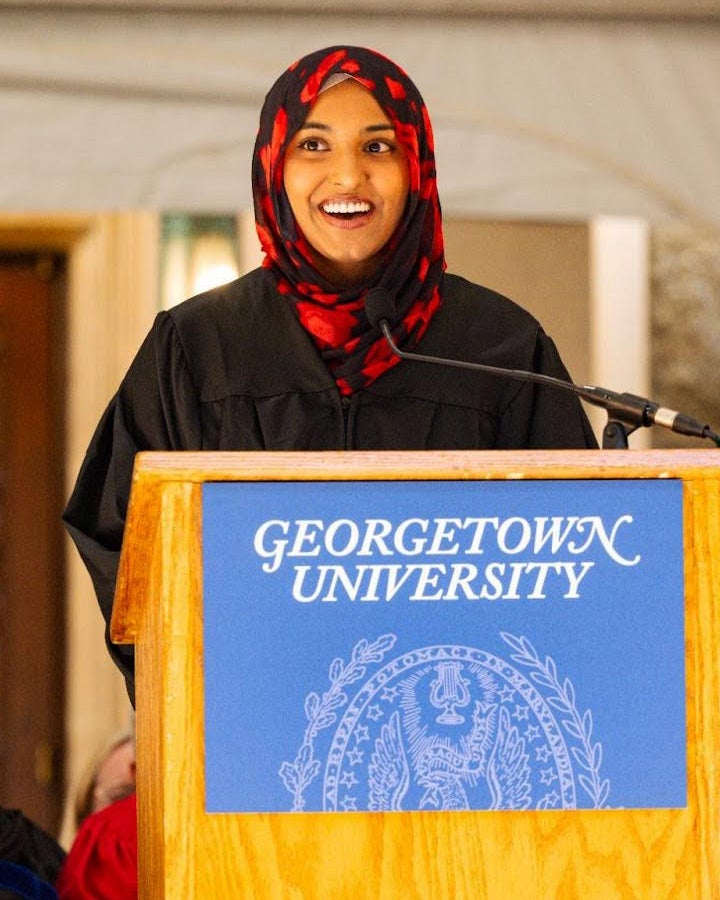
Isra Satiar (H’26) is this year’s recipient of the Thomas P. McTighe Prize, which is awarded to a student selected to address the opening convocation.
“The biggest mistake I made early on was thinking I had to handle all this myself. I thought asking for help was a weakness. I thought leaning on others was admitting defeat,” said Satiar in her address. “But the truth is, you are meant to be lifted here by professors who care deeply about your learning, by mentors who will see potential in you before you see it in yourself, by friends who will walk through the highs and lows… Georgetown became my home, and I promise it will become home for you, too.”
With the encouragement of her School of Health mentors, Dean Christopher King, PhD, FACHE, and Shabab Wahid, DrPH, assistant professor of global health, Satiar applied for one of the selective Projects for Peace awards sponsored by the Kathryn W. Davis Foundation that grants recipients $10,000 to pursue an innovative, community-centered and scalable response to one of the world’s most pressing issues. Under the guidance of the Center for Social Justice Research, Teaching and Service at Georgetown, Satiar applied for the award in January 2025. In March, Satiar learned that her proposed project on health education for Rohingya refugees in the Kutupalong Refugee Camp in Bangladesh was selected as one of this year’s awardees.
An Early Commitment to Global Health
As a high school student in northern Virginia, Satiar founded Generation Resilient, a volunteer refugee health organization. Satiar was motivated to found the organization after listening to her father’s travel stories about visiting orphanages in Bangladesh and noticing the absence of young girls. According to Satiar, girls were being turned away due to lack of support and facilities, and she sought to create an organization focused on youth health care and education for refugees, especially for girls not much younger than herself.
“I envisioned [building] a safe, supportive orphanage where young girls could enjoy the same rights and opportunities as their male counterparts,” said Satiar.
After she came across the human science program in the School of Health, Satiar applied because the program brought together several of her interests, including medicine and global health. “What also stood out to me was how service was deeply woven into the fabric of Georgetown,” said Satiar. “It matched the values I was raised with in my faith and family, and seemed like the place where I could grow as a student and as a person who wanted to use a career in medicine to serve others.”
Satiar continued to organize projects and events for Generation Resilient in between her human science studies, her neuroscience research at the School of Medicine, and her work in the ICU at MedStar Georgetown University Hospital. Last November, Satiar and some of her School of Health classmates organized a Pathways to Medicine event for Afghan refugee students of Alexandria City High School in Virginia. At the event, the Georgetown students gave first aid training and delivered a presentation on how to pursue different medical careers, including becoming an emergency medical technician and certified nurse practitioner.
“Hosting this event was a reminder of the immense privilege we have at Georgetown to pursue higher education without the barriers others face — barriers like war, language differences and discrimination,” said Satiar. “These refugee students share the same passion for medicine as we do, with dreams of becoming doctors and nurses, yet their challenges are far greater.”
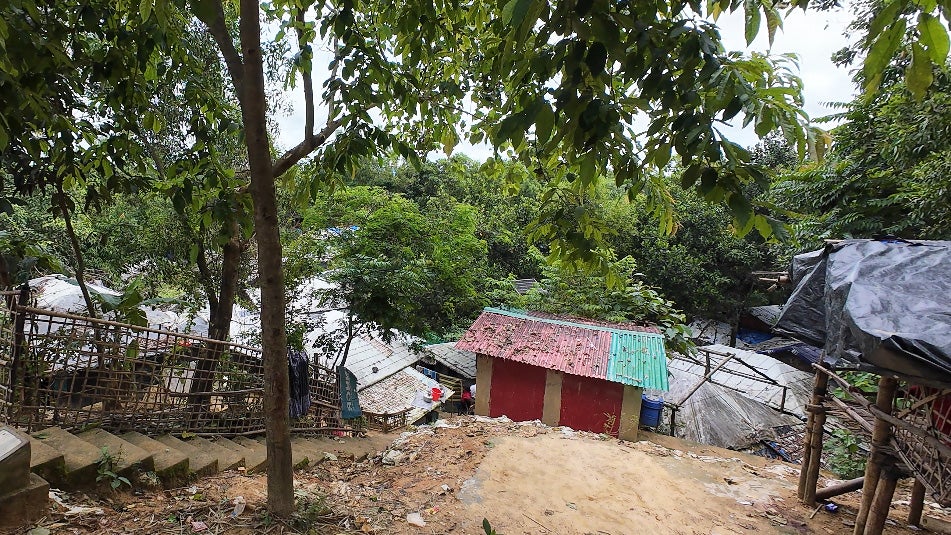
Camp 4 in Cox’s Bazar, near the Bangladesh-Myanmar border, is home to approximately 50,000 displaced Rohingya.
Volunteering in One of the World’s Most Densely Populated Places
Satiar received her Projects for Peace award, in part, in recognition of her work with Generation Resilient. This summer, she worked in Camp 4, one of the 33 camps in Cox’s Bazar, near the Bangladesh-Myanmar border. Over 1 million Rohingya refugees live in just 24 square miles, making the site one of the world’s most densely populated places and one of the largest refugee settlements in the world. Camp 4 is home to approximately 50,000 displaced Rohingya.
Satiar worked every day at a clinic run by a nonprofit involved with Rohingya refugee work for decades. The nonprofit also provided her lodging. Satiar described the weather as reaching temperatures of over 100 degrees daily with 95% humidity almost all of the time. She estimates she interacted with over 1,000 refugees throughout her time in the refugee camp.
“Communication wasn’t always easy,” said Satiar, who speaks fluent Bangla. “The refugees have lived in Bangladesh for nearly nine years, yet clear efforts to prevent integration mean the language barrier is still strong with refugees who only speak Rohingya.”
Satiar recalled seeing refugees suffering from conditions that are common in refugee camps, including scurvy and the mosquito-borne Zika virus. “One of the hardest things to witness was how illnesses that are completely treatable, and that we don’t even think about in the U.S. because they’re so rare, are still so present in the camps,” said Satiar. “The clinics had extremely long wait times, and resources were already stretched so thin.” According to Satiar, the recent major USAID funding cuts, which happened just days before she arrived, further deepened the crisis for people already living in vulnerable conditions.
Health and Humanity
Outside of her clinical work, Satiar worked on projects related to her Projects for Peace award, including hosting health education leadership workshops, providing individualized care packages, and creating a “comfort clinic.”
In the health education leadership workshops, Satiar taught refugees ages 18–25 essential life-saving skills she learned as a patient care tech at MedStar Georgetown, including how to take vitals and start an intravenous (IV) line to administer fluids when someone is suffering from heat exhaustion, a condition the Rohingya refugees commonly experience. In addition to these first aid focused workshops, Satiar taught disease prevention to school-aged children, such as wearing a mask and handwashing.
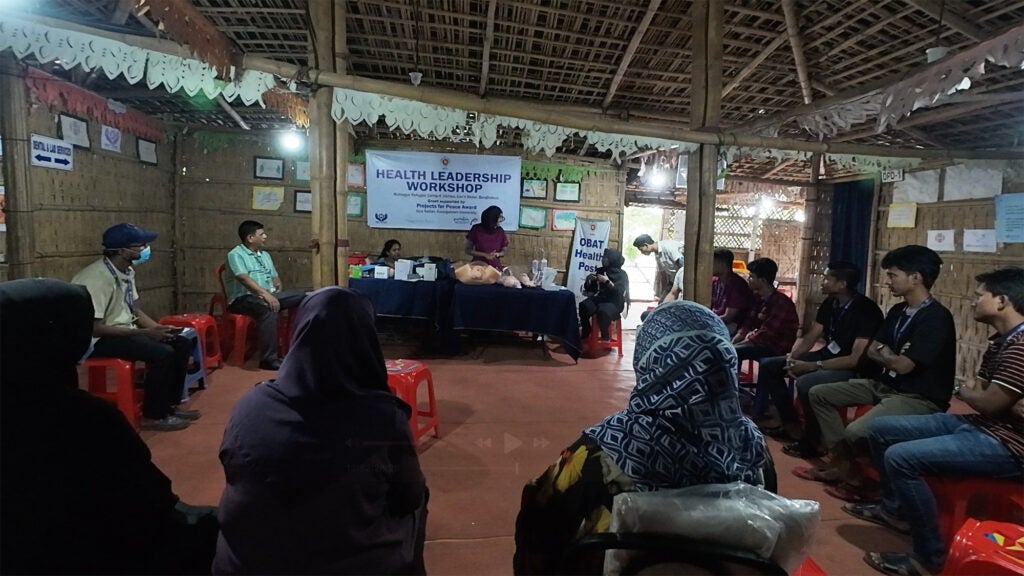
Satiar hosted health education leadership workshops.
She also created and distributed care packages to children that included items such as masks to protect against COVID-19 and other respiratory diseases, mosquito nets to protect against dengue fever, and personal hygiene items like soap and toothbrushes. “These are such basic items, but it was eye-opening to see how they were considered luxuries to children in the camps,” said Satiar.
The comfort clinic that Satiar created, which she described as a “trauma-informed healing space for youth,” was the first of its kind in any of the 33 camps. “I couldn’t stop thinking about how damaging an environment it must be for the children in the camps, growing up with no electricity, heavy humidity, and born into lives of displacement and persecution,” she said.
“I wanted to create even a small space where children could step away from all of that and feel a sense of home and safety, and finally just be a child, without carrying any other burden,” said Satiar. “I was very intentional about including Rohingya cultural items, along with toys and activities they don’t typically get to engage with, so they could have moments of play and feel like they were experiencing a normal childhood, even in the middle of the camp.”
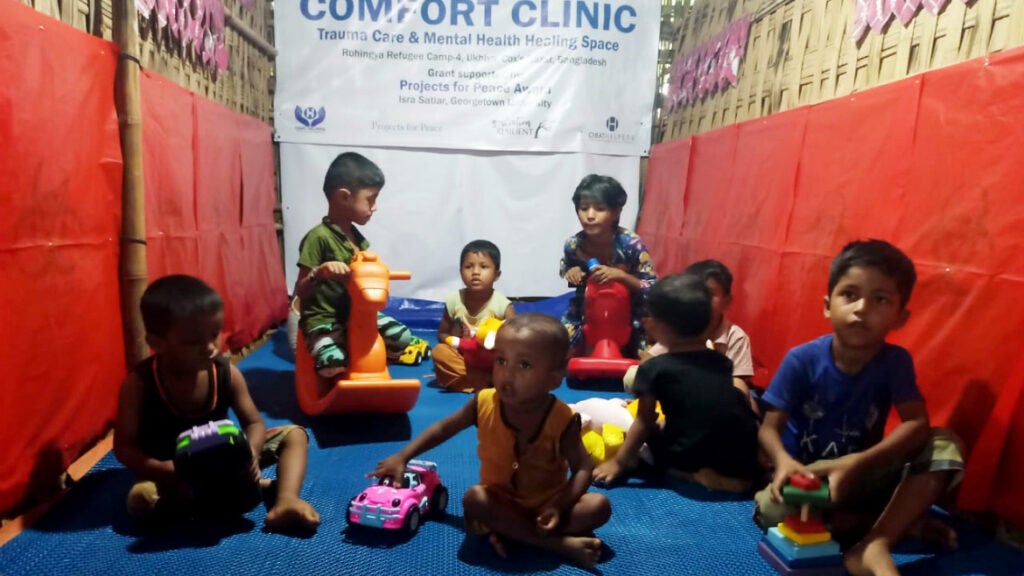
Satiar created the Comfort Clinic to allow children to “feel a sense of home and safety.”
Out of all the projects Satiar worked on while with the Rohingya refugees, she said the comfort clinic had the biggest impact on her. “Seeing kids choose to use the room on their own, sometimes even bringing friends along, showed me that the effort we put in was truly making a difference,” said Satiar.
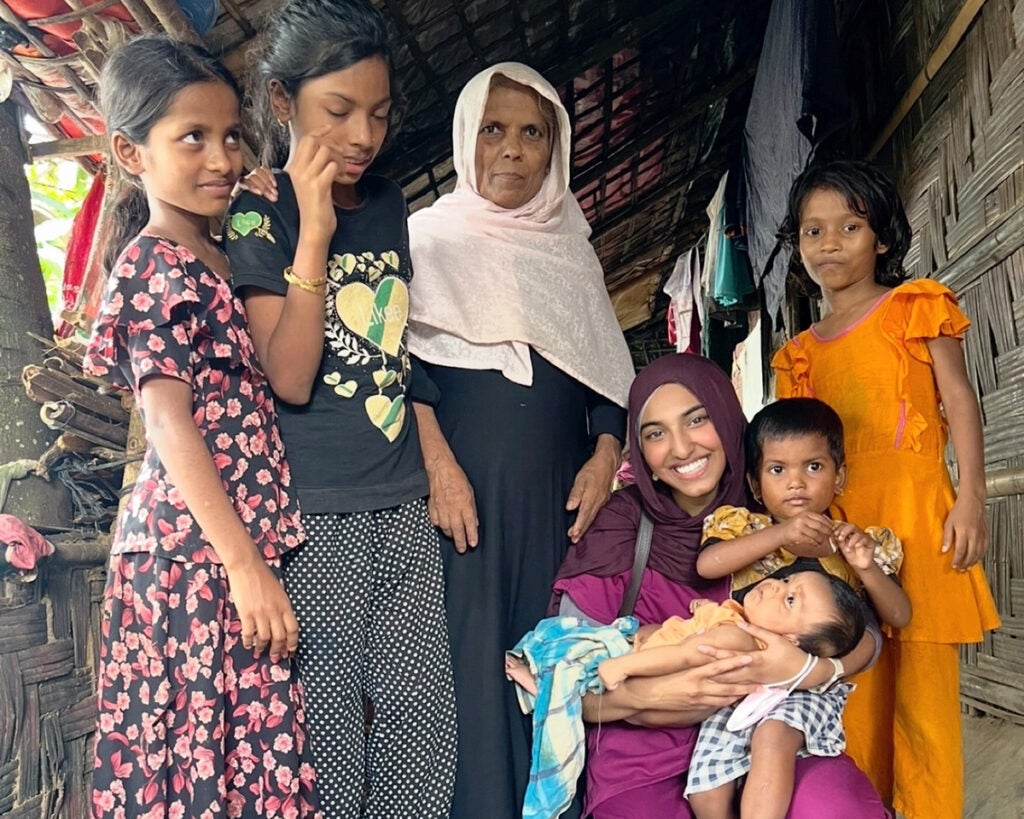
Satiar made personal connections with the refugees.
Satiar made personal connections with Rohingya refugees, even visiting their homes, which were 15-by-15-foot shelters with no lighting, often shared by several adults and children. Satiar recalled meeting an elderly woman who tried to make her lemonade from small plants growing behind her dwelling because she didn’t want to invite Satiar into her home without a food offering.
“Amidst all the suffering, it was moments like this where I learned not to see people by their situation but by who they are — as people unchanged in generosity despite how much has been stripped from them,” said Satiar. “The Rohingya are often labeled the most vulnerable in the world, but to me, they are the most resilient group of people I’ve ever met.”
Heather Wilpone-Welborn
GUMC Communications

